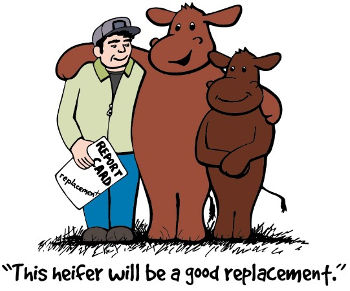By Kris Ringwall

Developing and maintaining a producing cow herd is no easy task, and doing that task well is close to the heart of every producer.
Even when the cows aren’t tagged, every producer can pick out the favorite cow or cows and recite a unique story about many of them. That brings us to the topic of “cowsonality,” the attitude and behavior exhibited by individual cows that contribute to their place in the development of a productive cow herd.
Those anecdotes are indicative of each cow’s cowsonality, which, if positive, is an important trait to retain in the herd.
That brings us to the process of who stays and who gets marketed, along with the debate of raising or buying replacements. Producers realize that successful cow herds are more than just what is on paper. Knowing the cowsonality within your cow herd is important and is often the reason producers opt to raise their own replacements. Good cow families are the core of a herd.
In the fall, as the cows are gathered, perhaps some reflection from the cow’s point of view is good:
“I have tried to keep an eye on you (the calf) as we follow the annual trek, a path I know well,” the cow says. “I hope you learned as I prepare to ‘cut the cord’ and say goodbye, at least for now. This summer was pleasant. The grass now is not what it was earlier in the year. The chill in the air means the horses and riders will be appearing on the horizon to take us home.
“It seems like yesterday when all 84 pounds of you arrived (the same weight as my first calf) during a dark, chilly April night with no complications. I am glad my producer has chosen some warmer times to calve. I certainly do not miss those cold nursing periods with minus 30-degree wind chills.
“When you were born, I had a slight chill, but a good time, and the help were proud when their flashlight showed you up and nursing. A gentle ‘moo’ satisfied them and they moved on to check a young heifer calving just below the hill.
“As I get older, I appreciate a lighter birthweight. I remember your 105-pound older brother. I had to more than sneeze to pop him out, but I was in my prime, a strong 6 years of age and boss of bunk No. 9.
“Today, at 12, I’m holding my own. This year had good, green grass over our knees. The rancher said the crested wheat was good this year, and the trails in the native summer pastures were familiar. That next generation of ‘know-it-alls’ who took over Bunk 9 last winter had to ask for guidance through the wide-open spaces of the northwest pasture.
“After all, I know the choice spots to graze and nurture a young, growing heifer like you. The watering holes soon were learned by all your friends; the smell of summer grass was soothing and produced milk for your well-being.
“Summer was one of those dry, but sometimes wet, years when we had to look a little harder to find the grass at times. The grass was good as riders started to scout the pasture for all the family. I know well where your cousin hides. For some reason, she is always the last to come in. I guess she is smarter than the average, but to no avail.
“Your growth report card is great. You weighed in at 608 pounds, gained 2.14 pounds a day, framed in at 5.5 and weighed 2.48 pounds per day of age. I’m pleased at how you have performed, and I noticed you didn’t get unruly when the herdsman gave you your vaccinations. That is a plus.
“I remember one of your sisters turning on the herdsman when she came out of the chute. I haven’t seen her since. The crew mumbled something about disposition, and your father’s temper, which your sister inherited.
“Let’s enjoy these next couple of weeks. If history holds, once we are turned into the stubble, our final separation is not too far away. I noticed the word ‘replacement’ on the comment section of your report card. The other heifers averaged 536 pounds, so that puts your ranking very high. With a 5.5 frame score, you will fit in fine.
“My advice to you: Eat a balanced diet, watch your winter weight gain and wiggle your ears when you see anybody with a pipette in their hand in the spring. Now, I can feel Junior doing a few cartwheels getting ready for next spring’s delivery, so we better get back to eating to maintain my current weight at 1,250 pounds and condition score at 6. At my age, I don’t want to give the crew any reason to look twice.”
At the same time, producers looking over the herd may be wondering, “What is that cow really thinking?”
Cowsonality is real and, when selecting replacements, I hope it is making the cow herd more functional and productive. The best advice for producers may need to be filtered by taking time to understand the cows within the herd, and after a lifetime of understanding, a producer becomes a rancher, one who knows the land and the cattle.
Remember to take care and appreciate that individual cowsonality, and that cow will take care of you.
Source: ndsu.edu